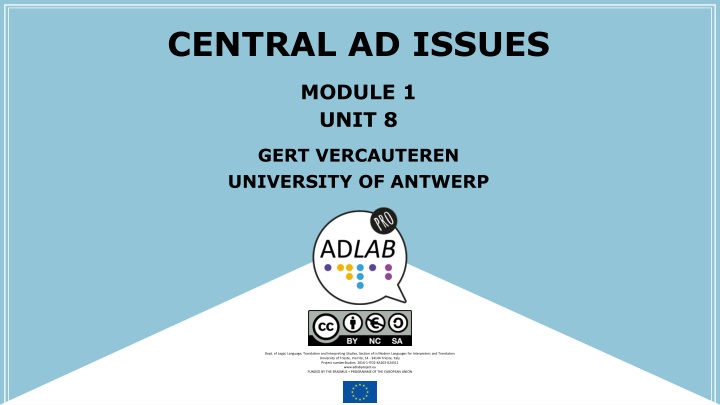
Essential Guidelines for Audio Description in Visual Media
Explore key considerations for effective audio description in visual media, including what, when, how, and how much to describe. Gain insights into describing images, sounds, and text on screen to enhance accessibility and engagement for diverse audiences.
Download Presentation

Please find below an Image/Link to download the presentation.
The content on the website is provided AS IS for your information and personal use only. It may not be sold, licensed, or shared on other websites without obtaining consent from the author. If you encounter any issues during the download, it is possible that the publisher has removed the file from their server.
You are allowed to download the files provided on this website for personal or commercial use, subject to the condition that they are used lawfully. All files are the property of their respective owners.
The content on the website is provided AS IS for your information and personal use only. It may not be sold, licensed, or shared on other websites without obtaining consent from the author.
E N D
Presentation Transcript
CENTRAL AD ISSUES MODULE 1 UNIT 8 GERT VERCAUTEREN UNIVERSITY OF ANTWERP Dept. of Legal, Language, Translation and Interpreting Studies, Section of in Modern Languages for Interpreters and Translators University of Trieste, Via Filzi, 14 - 34144 Trieste, Italy Project numberStudies: 2016-1-IT02-KA203-024311 www.adlabproject.eu FUNDED BY THE ERASMUS + PROGRAMME OF THE EUROPEAN UNION
INTRODUCTION TO THE UNIT Basis: - Existing (inter)national guidelines; - Early academic articles
FOUR ESSENTIAL QUESTIONS - What should be described? - When should it be described? - How should it be described? - How much should be described?
WHAT SHOULD BE DESCRIBED? Everything there is to see on screen Too much Not enough CONTRADICTION?
WHAT SHOULD BE DESCRIBED? IMAGES - Characters - Actions - Setting => who does what, when and where
WHAT SHOULD BE DESCRIBED? SOUNDS - Ambiguous sound effects - Foreign dialogues (audio subtitling, dubbing or voice-over)
WHAT SHOULD BE DESCRIBED? TEXT ON SCREEN - Logos - Opening & closing titles - Text on signs in the images
WHEN SHOULD IT BE DESCRIBED? When the production is completely silent. - Never describe over dialogues - Avoid describing over relevant sounds
HOW SHOULD IT BE DESCRIBED? Language & style of the description - Natural language - Not too complicated, simple sentences (don t avoid metaphors) - Vivid & varied language, clear and precise - Matching the programme - Matching the audience
HOW MUCH SHOULD BE DESCRIBED? No clear answers yet don t describe too much - Indication: +/- 17 CPS or 180 WPM - Adapted to programme scene (panoramic view vs. Action)
CENTRAL AD ISSUES MODULE 1 UNIT 8 GERT VERCAUTEREN UNIVERSITY OF ANTWERP Dept. of Legal, Language, Translation and Interpreting Studies, Section of in Modern Languages for Interpreters and Translators University of Trieste, Via Filzi, 14 - 34144 Trieste, Italy Project numberStudies: 2016-1-IT02-KA203-024311 www.adlabproject.eu FUNDED BY THE ERASMUS + PROGRAMME OF THE EUROPEAN UNION
The preparation of this presentation was supported by ADLAB PRO (Audio Description: A Laboratory for the Development of a New Professional Profile), financed by the European Union under the Erasmus+ Programme, Key Action 2 Strategic Partnerships, Project number:2016-1-IT02-KA203-024311.
The information and views set out in this presentation are those of the authors and do not necessarily reflect the official opinion of the European Union. Neither the European Union institutions and bodies nor any person acting on their behalf may be held responsible for the use which may be made of the information contained therein.






















